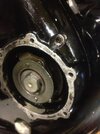My ATD does not spring back against the stops, but stops about half way or perhaps 3/4 of the way. And it does seem like the springs are weak. How many weeks will it take for me to change the springs=(
I had the same problem woth my Comet - I am using a Magneto. There are a few things to try. First up a liberal spray of WD-40 into/over the ADT mech just in case there is any old gummy oil on its pivots then give it a good workout by hand operating it full travel a few times. Next you need to go to the other end - the points within the magneto and make sure they also operate well in respect to the points cam. In a magneto you will have a ring cam and again WD-40 should be used to clean the rubbing surface and once clean then a small touch of hi temp grease onto the cam surface - I use a "cotton bud" to apply it with my magneto.
If you still have issues then you may want to try replacing the ATD springs. There are 3 grades of spring available from the VOC Spares company - Standard, stronger and bloody strong, however before you start playing with the springs it may be useful for you to look at this site
http://brightsparkmagnetos.com/faqs... is the spring rate and preload in an ATD.htm
The VOC Spares Company springs part numbers are:
407256 - Velocette heaviest,
416060 - 500cc AJS/Matchless middle, (BTW These are what I have fitted to my ATD)
498154 - lightest all others including Vincent, Norton, BSA etc, etc.
Here is a link to the VOC Spares Company
https://vocspares.mamutweb.com/Account/Logon?ReturnUrl=/Shop/List
And finally, from the archives, Big Sid's instruction on changing ATD springs
" One can often shorten a spring that fits loosely by cutting off the end loop and bending over the next one or the second one if careful . With the cover off and the center nut still tight so it's taper is well set you proceed as follows . Carefully back off on the center nut just enough to slip out the horseshoe and tin disc so revealing the springs . Go easy not to back off the inner removal mechanism .
Change the springs , now accessible , be sure they tug on the peg , not hang loose , trim off the end loop and reform if needed .
Tuck in a piece of cloth below in the opening to prevent dropping in the spring ! Remove the cloth . Replace the tin disc and the horseshoe washer . If this is bent up , often is , flatten it first . Re tighten the center bolt holding all in position carefully .
Replace the cover . All done . Good luck . Sid . "
Hope this is of some help
Martyn

